Cedarmountain here on TFL got me interested in making miso after he replied to my blog post about my red miso furikake sourdough. One major ingredient needed to make miso paste from scratch so I learned from him was koji rice. From Tartine Book No. 3 “Koji is the traditional Japanese food culture of rice inoculated with Aspergillus oryzae mold. It has been used for more than two thousand years to make miso, sake, soy sauce, amazements, pickles, and many other umami-rich foods that form the backbone of Japanese cuisine.” We have a local sake producer here in Toronto Canada that happens to sell koji rice. I plan on starting my miso making project soon but in the meantime I was very interested to taste koji rice and wanted to try making koji rice porridge sourdough.
I adapted the recipe from Tartine Book No. 3 and blended it with an oat porridge sourdough from Maurizio of The Perfect Loaf as I liked his methods in the past. This adapted formula has a lot of rice porridge in it, the rice is 50% in baker’s math and based on the photos in Tartine, I wasn’t expecting much oven spring from this bread since the rice porridge is such a high percentage of the dough and is weighing it down. I was still surprised at how flat the resulting loaf came out. If the flavour of the koji rice comes through strongly enough then I might be able to reduce the amount of koji rice in the bread and hopefully improve oven spring next time around. On the other hand it might also be that the bread is overproofed. The extra sugar in the dough from the koji may have moved fermentation along quickly and waiting for 45% rise in the dough may have been too much proofing since the dough had to overcome the weight of the rice. The crumb will show what the truth is as usual.
I should mention that the cooked koji rice is quite delicious and has a nice sweetness to it so one has to bake this bread at a lower temperature once the steaming portion of the bake is over.
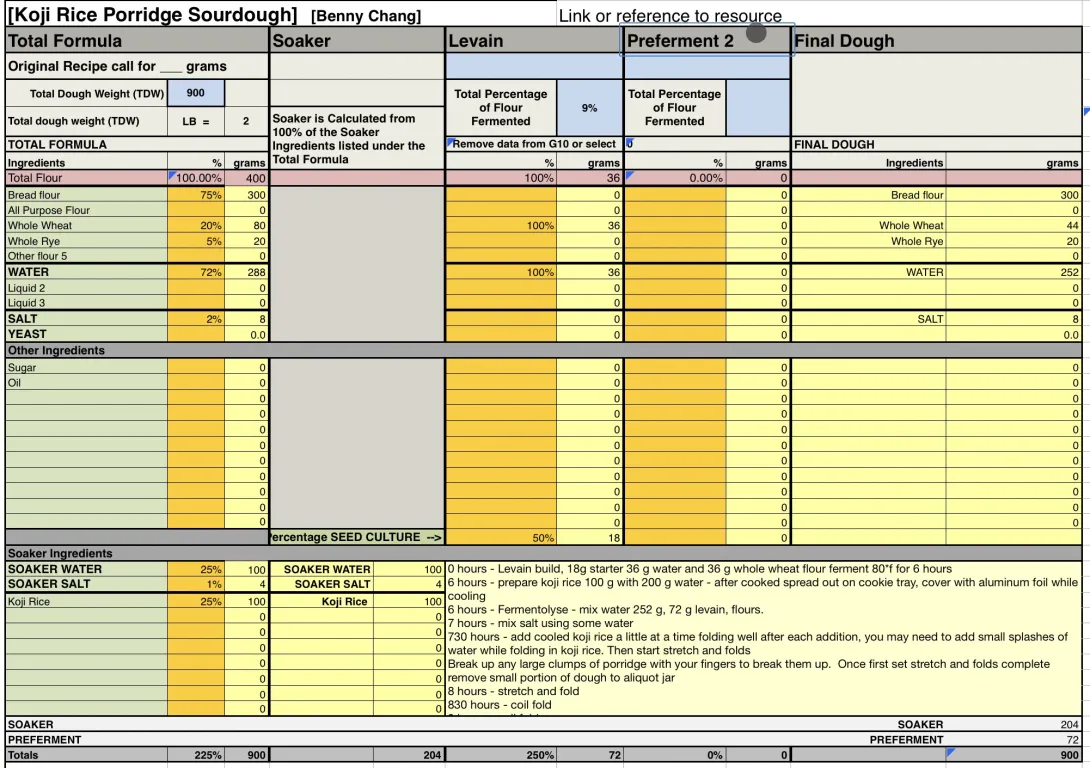
0 hours - Levain build, 18g starter 36 g water and 36 g whole wheat flour ferment 80*f for 6 hours
6 hours - prepare koji rice 100 g with 200 g water - after cooked spread out on cookie tray, cover with aluminum foil while cooling
6 hours - Fermentolyse - mix water 252 g, 72 g levain, flours.
7 hours - mix salt using some water then do slap and folds to ensure well incorporated and build gluten.
730 hours - add cooled koji rice a little at a time folding well after each addition, you may need to add small splashes of water while folding in koji rice. Then start stretch and folds
Break of any large clumps of porridge with your fingers to break them up. Once first set stretch and folds complete remove small portion of dough to aliquot jar
8 hours - stretch and fold
830 hours - coil fold or consider a lamination
9 hours - coil fold
930 hours - coil fold
10 hours - coil fold
13 hours - end of bulk 6 hours after salt mixed - bulk rise 50% in aliquot jar - go to shaping - 30 mins bench rest then cold retard until baking next day
Following day - preheat oven with dutch oven at 500*F for 1 hour
Bake in dutch oven 20 mins the drop temperature to 450*F keeping lid on, then remove cover and drop temperature to 375-400*F (dough has a lot of sugar so will brown quickly) and complete bake may take 30 mins or so before crumb fully baked.
- Benito's Blog
- Log in or register to post comments
Out of the oven. Liking the crust.
Image
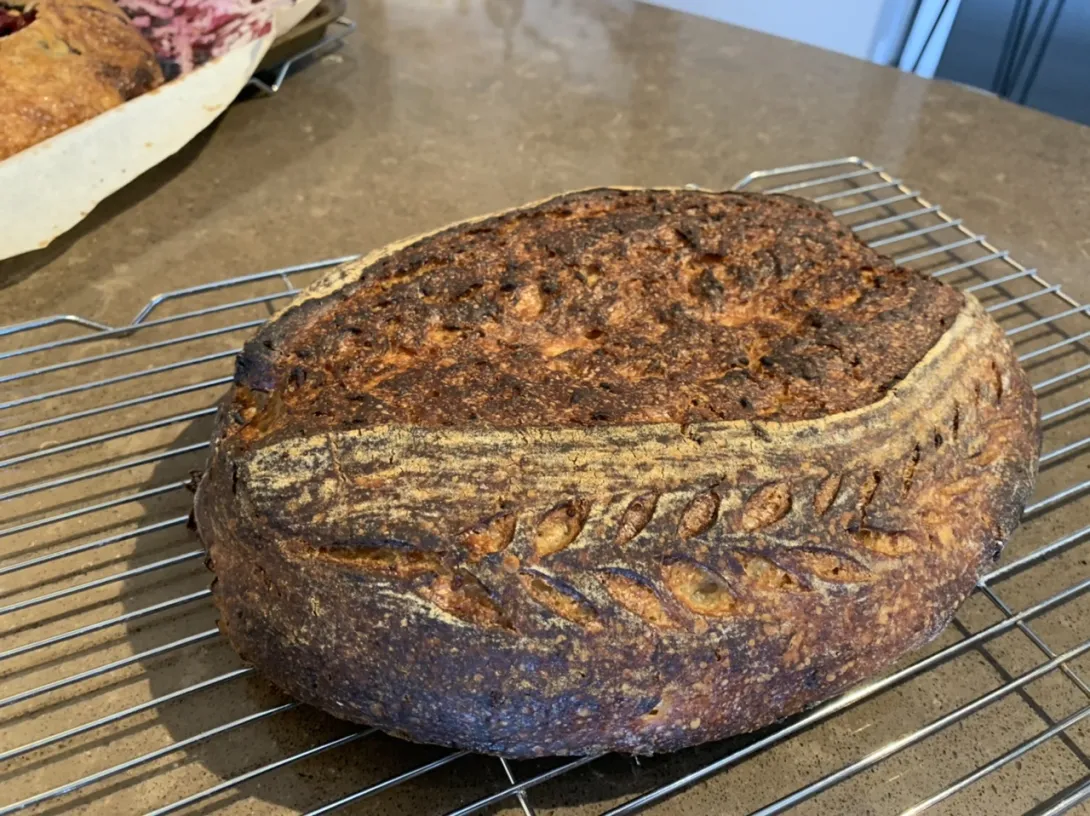
Image
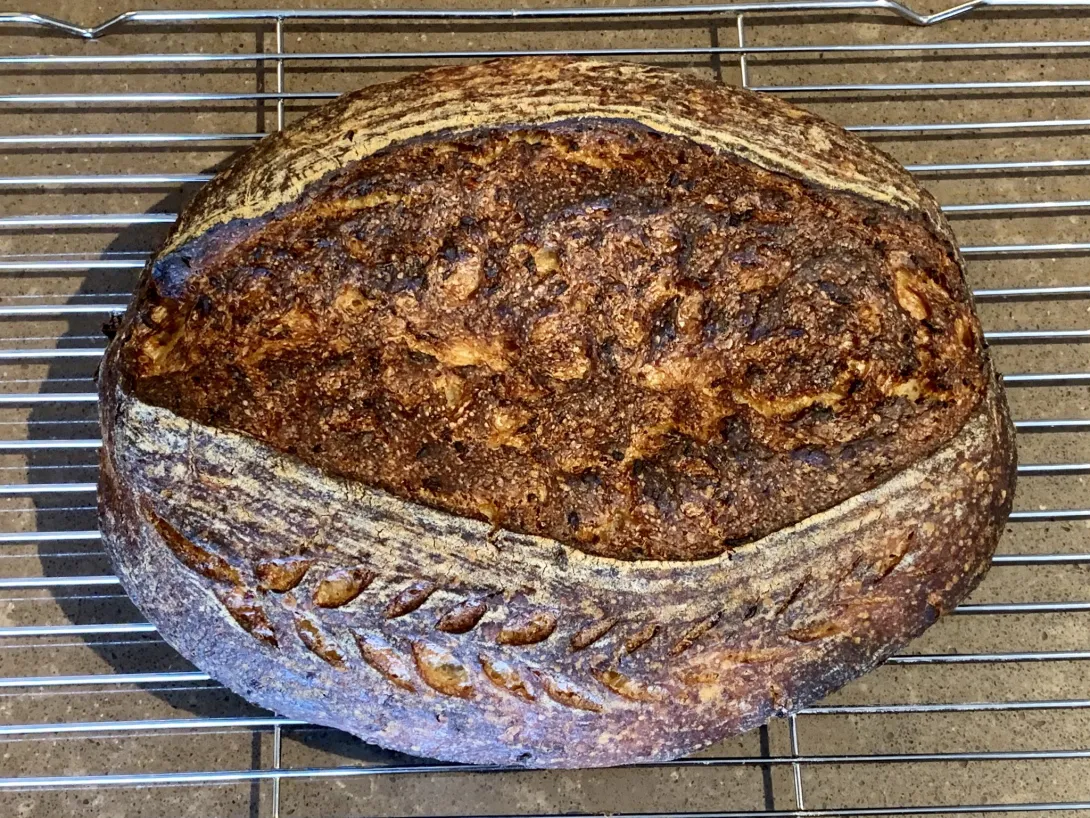
While sometimes the word koji used that way, I think definition of Koji 麹菌 is clearer as the mold itself Aspergillus oryzae. If you buy koji to make make products it is often rice
inoculated with koji known as komikoji 米麹. But the actual mold is the koji. It is similar to how we say sourdough starter which is the flour with other stuff in it, but the actual bacteria is a thing on its own.
Thanks for the clarification Edo. There’s always something new to learn.
It is interesting watching your experiments - I use a lot of these ingredients for other things - and seeing them in your bread is intriguing!
Well this formula wasn’t that successful, not enough oven spring. Once I slice it I’ll have a better idea if it was due to overproofing or simply the percentage of rice porridge in the dough. Robertson said that he used 50% rice in order to be able to taste the koji rice sufficiently.
I am quite interested in using some Asian ingredients in sourdough, in North American at least, you just don’t see these being used much. Unfortunately some experiments are less successful than others.
have gained popularity among Asian bakers since a few years ago. Many Japanese and Taiwanese bakers in particular, have ventured into soy sauce, miso and shio koji bread. Although the majority of these formulas include instant dry yeast, they still serve as reference when determining the amount of condiment used. You may consider looking them up if you haven't already.
Not sure how much sugar is in your koji rice porridge. It may inhibit LAB activity if the concentration gets too high... But let's wait till we see the crumb! It certainly looks nice on the outside.
The crumb is very moist and custard like, that I really like. I guess that would be typical for porridge breads in general. Despite koji rice having a very distinct flavour when eaten I could not detect its flavour in the finished bread, that was disappointing to me. Using 50% rice as per Tartine may just to too little to taste the flavour, yet be too much to get a good rise from the bread. If the koji rice is primarily acting like most porridge added to bread and I wanted more lift then I would consider decreasing it quite a bit from 50% to get a better looking loaf. I don’t know how much sugar the koji rice brings with it, but it definitely had some sweetness when eaten alone. I don’t think that the sugar in the koji rice inhibited the LAB very much as the crust in particular still had a nice light tang.
It is kind of neat that you can see some of the rice in the crumb.
Image
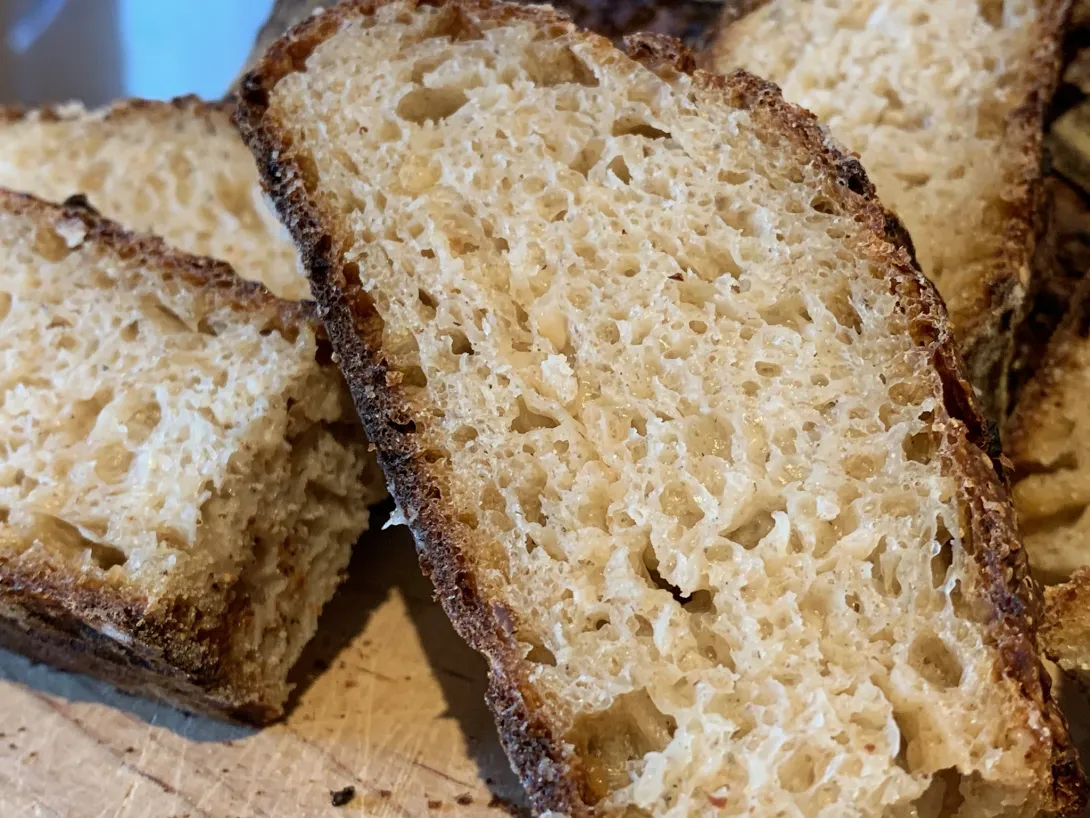
Image
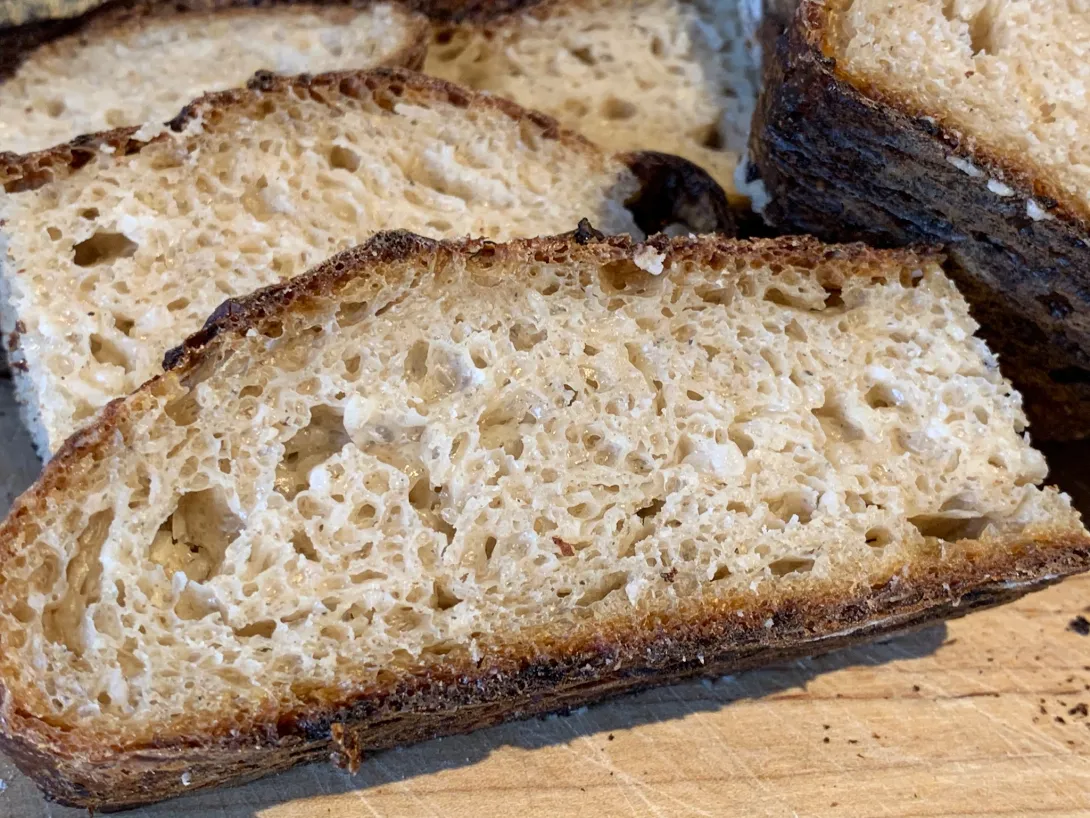
Image
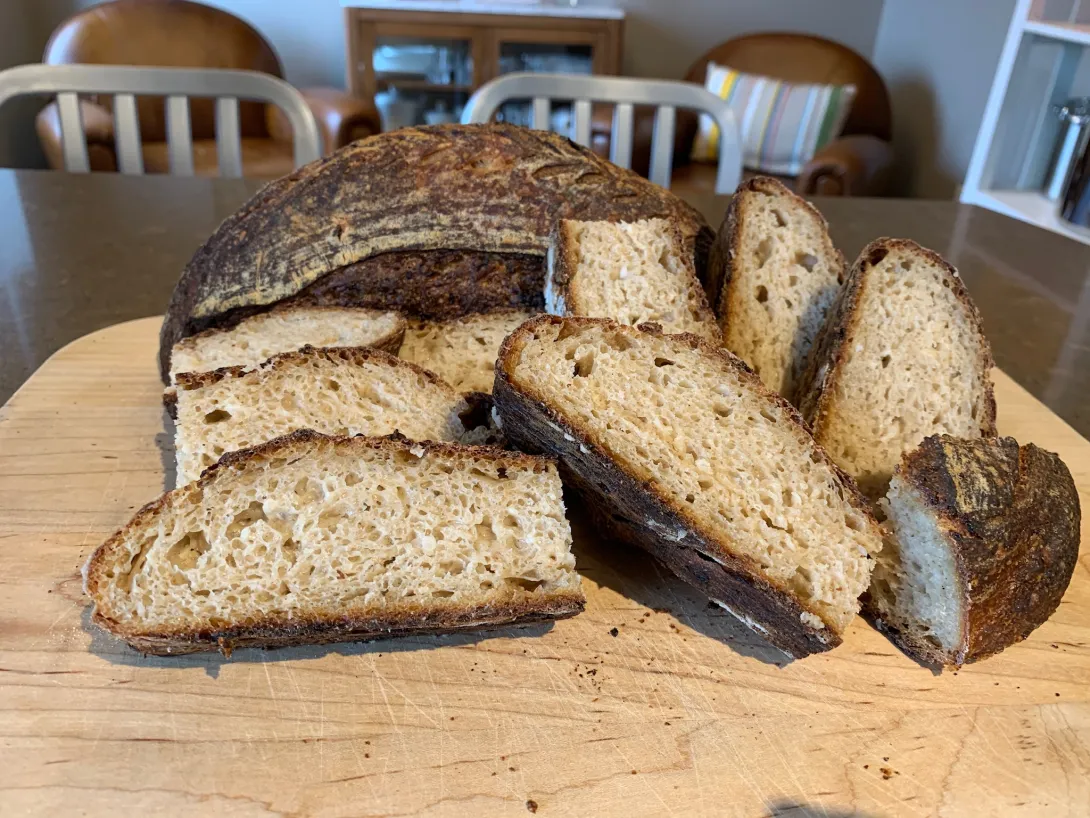
Hi Benny,
I this yt baker using koji rice in his bread. The yt only gave a partial insight but it had this information
Mix 200 g cooked rice with 30g koji rice (see package from the store) and 120 g water.
The 3 ingred are mixed together and left overnight- the grains are not broken down.
The next day , 1-2 hours before the dough is assembled, the baker blends the mix to remove the lumps. Apparently he wants to reserve the core of the rice until this stage.
Do you think it would be good to try 100 g of his rice/koji/water with 400 g total flour?
Thanks!
See 26:07-27:55 at
https://www.youtube.com/watch?v=H-DCjAYD7_0
Solo baker in the countryside, 20 kinds of bread, Sold out in 2.5 hours | Sourdough Bread in JapanREIYA Watanabe | Japanese
Hi Jo-en, sorry I’m just seeing this. I’ve been away for several weeks and just getting settled back in here at home. Your suggested ratio will likely be much better than what I produced earlier with 50% rice. You will still need some of your levain or commercial yeast for leavening since I’d be shocked if the koji rice on its own could leaven this dough. However, if you try it on its own, I’d love to learn from you.
Benny
Hi Benny,
I made the koji/cold rice "tangzhong" (TZ) and incorporated it in my usual 100% ww clas loaf.
I got a noticeably soft loaf but it has a bit of a wet feeling. These are better than they look. The crumb glistens too much!
Based on TZ, the rice made 4.35% total flour but I did not taste the koji ferment.
400 fr ground ww
44 whole rye from clas
20 gr rice+koji from TZ (218.18% hydration) (used 64 gr TZ)
Not sure what to do next since I am using so little koji rice (but little taste) and the dough is already too wet for my tastes.
So nothing to report here!
I guess we’d need to use a fair amount of koji rice in order to taste it. It is fun to play with things like this though, so many possibilities.